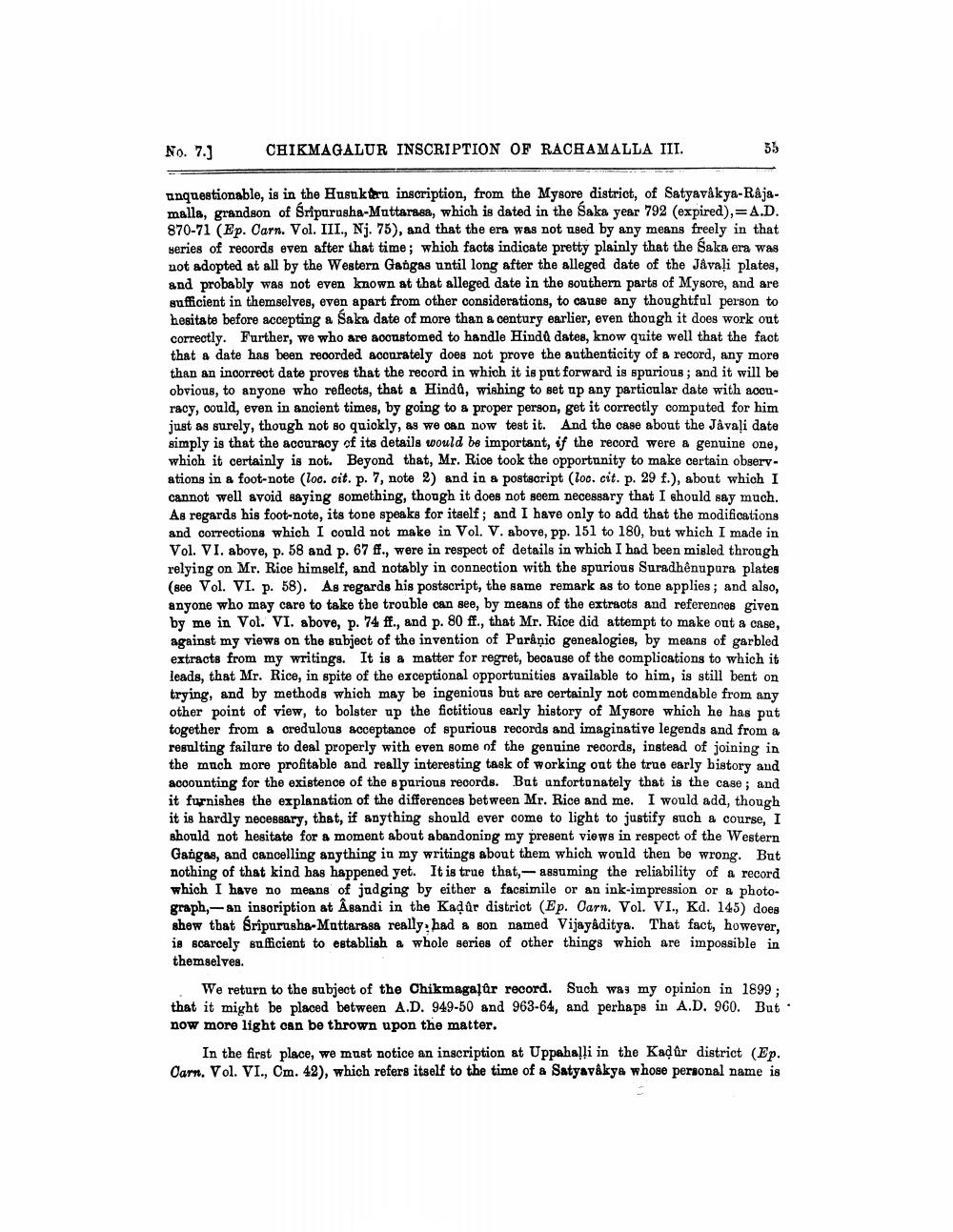________________
No. 7.)
CHIKMAGALUR INSCRIPTION OF RACHAMALLA III.
anquestionable, is in the Husnkteru inscription, from the Mysore district, of Satyavákya-Rajamalla, grandson of Sripurusha-Muttarasa, which is dated in the Saka year 792 (expired),=A.D. 870-71 (Ep. Oarn. Vol. III., Nj. 75), and that the era was not used by any means freely in that series of records even after that time; which facts indicate pretty plainly that the Saka era was not adopted at all by the Western Gangas until long after the alleged date of the Javali plates, and probably was not even known at that alleged date in the southern parts of Mysore, and are sufficient in themselves, even apart from other considerations, to cause any thoughtful person to hesitate before accepting a Saka date of more than a century earlier, even though it does work out correctly. Further, we who are accustomed to handle Hindê dates, know quite well that the fact that a date has been recorded accurately does not prove the authenticity of a record, any more than an incorrect date proves that the record in which it is put forward is spurious, and it will be obvious, to anyone who reflects, that a Hinda, wishing to set up any particular date with acouracy, could, even in ancient times, by going to a proper person, get it correctly computed for him just as surely, though not so quickly, as we can now test it. And the case about the Javali date simply is that the accuracy of its details would be important, if the record were a genuine one, which it certainly is not. Beyond that, Mr. Rice took the opportunity to make certain obseryations in a foot-note (loc. cit. p. 7, note 2) and in a postscript (loc. cit. p. 29 f.), about which I cannot well avoid saying something, though it does not seem necessary that I should say much. As regards his foot-note, its tone speaks for itself; and I have only to add that the modifications and corrections which I could not make in Vol. V. above, pp. 151 to 180, but which I made in Vol. VI. above, p. 58 and p. 67 ff., were in respect of details in which I had been misled through relying on Mr. Rice himself, and notably in connection with the spurious Suradhenupara plates (see Vol. VI. p. 58). As regards his postscript, the same remark as to tone applies; and also, anyone who may care to take the trouble can see, by means of the extracts and references given by me in Vol. VI. above, p. 74 ff., and p. 80 ff., that Mr. Rice did attempt to make out a case, against my views on the subject of the invention of Puriņic genealogies, by means of garbled extracts from my writings. It is a matter for regret, because of the complications to which it leads, that Mr. Rice, in spite of the exceptional opportunities available to him, is still bent on trying, and by methods which may be ingenious but are certainly not commendable from any other point of view, to bolster up the fictitious early history of Mysore which he has put together from a credulous acceptance of spurious records and imaginative legends and from a resulting failure to deal properly with even some of the genuine records, instead of joining in the much more profitable and really interesting task of working out the true early bistory and accounting for the existence of the sparious records. But unfortonately that is the case; and it furnishes the explanation of the differences between Mr. Rice and me. I would add, though it is hardly necessary, that, if anything should ever come to light to justify such a course, I should not hesitate for a moment about abandoning my present views in respect of the Western Gangas, and cancelling anything in my writings about them which would then be wrong. But nothing of that kind has happened yet. It is true that, - assuming the reliability of a record which I have no means of judging by either a facsimile or an ink-impression or a photograph,- an inscription at Âgandi in the Kadur district (Ep. Carn. Vol. VI., Kd. 145) does shew that Sriparusha-Mattarasa really had a son named Vijayaditya. That fact, however, is scarcely sufficient to establish a whole series of other things which are impossible in themselves.
We return to the subject of the Chikmagalur record. Such way my opinion in 1899 : that it might be placed between A.D. 949-50 and 963-64, and perhaps in A.D. 960. But now more light can be thrown upon the matter.
In the first place, we must notice an inscription at Uppahalli in the Kad or district (Ep. Oam. Vol. VI., Om. 42), which refers itself to the time of a Satyavákya whose personal name is




